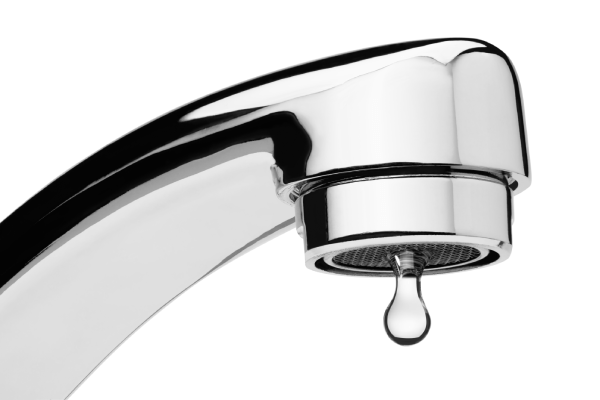
The average water pressure in U.S. homes is between 40 and 60 PSI (pounds per square inch). When the pressure is lower than that, it can be time-consuming to shower or use the dishwasher. Other than the inconvenience, it could be a sign of systemic plumbing problems. In this article, we’ll explore some of the top reasons why you have low water pressure in your home.
1. Defective Fixtures Are Leaking
One reason behind the low water pressure could be aging fixtures that drip or leak. The defective water fittings can waste a considerable amount of water and raise your utility bills. Studies show that a tap dripping every second will lose more than 3,000 gallons every year.
If only a few parts of your home have low pressure, it is probably an issue with faulty fixtures. For example, the faucet has aerators that manage the flow of water and make its flow smoother. When they are functioning as they should, the pressure should not be affected.
However, mineral buildup can cause blockages and reduce the pressure of the water in the process. Sometimes you can fix the issue by cleaning the aerator. But if the fixture is faulty, the faucet will need a replacement. Repairing your plumbing is a cost-effective way of optimizing its efficiency and function.
2. Your Pipes Are Leaking
It is also possible that your pipes are leaking, causing a drop in water pressure. This is different from a fixture leak. When the piping is subject to expansion and contraction, the strain can damage the metal. As temperatures fluctuate, the pipe will progressively develop cracks.
Sometimes the placement of the pipe may expose it to temperature fluctuation. We recommend insulation to protect your plumbing in vulnerable areas such as the attic. They are particularly prone to damage during the cold winter weather. Freezing water will expand and burst its walls.
The pipes may also develop cracks when the water pressure is above its natural level. Loose connectors and joints could start leaks that may end up reducing the water pressure. Beyer Plumbing staff in San Antonio utilize the latest tools to locate leakages for pipes that are inaccessible.
Another possible source of the leaks is invading tree roots. Roots can puncture the pipe and cause leaks. Trees in the proximity of the building may increase the chances of such leakages. Additionally, the elevation of your home can lower the pressure further.
Signs your plumbing is leaking include:
- A sudden rise in utility bills
- Hissing sounds from the pipes
- Pools of water on floors and walls
- Abnormal grass growth on your lawn
3. Clogging in Your Plumbing
Clogging is another factor that may be behind the low water pressure in your home. Even though most people associate clogs with the kitchen and bathroom drain, they can be problematic for your pipes too. A buildup of minerals can reduce the volume, blocking the flow of water to reduce the pressure.
The water supply in San Antonio is among the hardest in America, thanks to the aquifers that provide the water. The lasting solution for such cases is to install a water softener to prevent scale from blocking your pipes.
Reducing the mineral content in the water will also make washing dishes and chores less strenuous. Softening will make the water taste better and soap lathers much faster. Soft water is also safer for your water heater, which tends to breakdown due to the accumulation of scale.
Regardless of the nature of the blockage, Beyer Plumbing can eliminate the most persistent clogs in San Antonio. The piping is often in hard-to-reach places, and the clog may take time to clear. If the plumbers find an issue with your pipes, they will take their time to explain the solution.
4. Corrosion in Your Pipes
Corrosion in your piping can thicken the internal walls, and it will, in effect, reduce its total volume. The rate of deterioration depends on your pipe and factors related to the quality of water. For example, galvanized pipes are prone to rust and have a shorter lifespan than copper or brass.
To avoid corrosion, the pH level of the water should be neutral, otherwise, it will deteriorate your plumbing fixtures. If the pH is above 8.5 and below 7, it will damage the copper pipes’ protective layer. It is also worth noting that water with a very high or low pH can be harmful to your health.
Another factor is the speed of the water through your plumbing. Water turbulence around joints and connections can trigger rusting through the process of hydraulic wear. The rate will be higher if there is a considerable amount of dissolved oxygen in the water.
5. Issues With the Shutoff and Meter Valves
Before you think of scheduling an inspection of your plumbing, you should ensure the shutoff valve is fully open. The valve may have been shut partially during maintenance or in the cold season to prevent pipes from fracturing.
The shutoff valve is usually next to the point where the main water supply enters your house. For homes built on a slab, you may find it inside the garage. Residential buildings with crawlspaces will have a valve near the front of the house.
The meter valve could also be partially closed and may be obstructing the flow of water to the house. Unfortunately, the valve is not always accessible. It is often used by staff from your local company. You can locate it next to the meter, making sure it is fully open to restore the water pressure.
6. Faulty Pressure Valve Regulator
The pressure regulator is a device that ensures water going into your home remains at constant pressure. When the force of the water is high, a compressor can automatically reduce the pressure getting into your house. Some devices have screws that you can turn to increase or decrease to a level that meets the household’s needs.
If the device is faulty, there will be a sudden and noticeable drop in your plumbing. The most accurate way to determine if it is defective is to use a gauge to test both sides of the valve. The readings should be between 45 and 60 PSI.
It is best to leave the work of repairing the pressure regulator to a certified plumber. The process requires shutting off the main valve to prevent flooding and water damage. Our Beyer Plumbing team in San Antonio can replace the fixture and pressure levels to meet regular standards.
7. New Plumbing Fixtures
The water pressure may also drop If you have had a new installation recently. The demand from the additional fixtures must match the capacity of the central supply system. It may involve changing the pipework from the meter after a thorough evaluation of your plumbing. Our certified plumbers can propose cost-effective solutions to restore the water pressure in your home.
Regardless of your water supply problem, you can depend on Buyer Plumbing staff in San Antonio for quality plumbing services. You can rely on our professional team for replacements, repair, and maintenance of your piping. Our BBB A+ rated staff can provide exceptional water softening, tankless water heater, or tub installation solutions.
For exceptional plumbing services in San Antonio, don’t hesitate to call the Beyer Plumbing team today.


